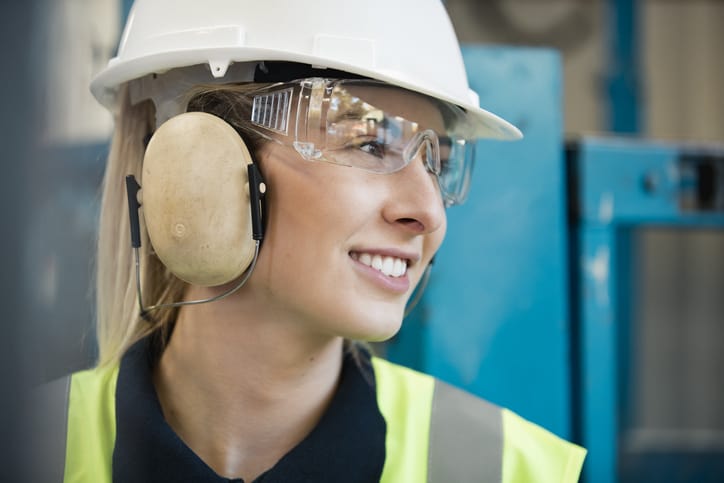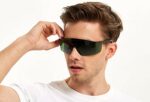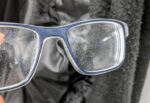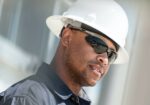In the previous article, we have discussed the importance of safety glasses in a dangerous work environment. The safety classes you purchase should have certain safety standards so that your eyes are absolutely protected from anything that can harm them.
When buying a pair of safety glasses, you’ll see a variety of markings that signify different eyewear safety classifications. These symbols, which are part of the ANSI Z87, represent particular eyewear safety ratings.
ANSI Z87+ certified safety glasses are developed and engineered to keep you safe. They are put through extensive testing, research, and design. The risk of harmful and hazardous items harming your eyes is reduced when you wear safety glasses with this rating.
The ANSI Z87+ ratings are designed to protect those wearing them from chemical splashes, heavy impact, dust dispersal and particles, and even radiation.

How to understand the markings?
For you to make a smart choice about which safety glasses you should go for, you need to have a basic understanding of how to read and understand the labels. Your safety glass might come with these markings below:
1.) z87+: The z87 designation denotes that the glasses have been tested for regular impact, whereas the z87+ designation denotes that they have been tested for high-impact.
2.) D3 and D4: D3 indicates that the glasses have been tested for chemical resistance, while D4 indicates that they have been tested for a full splash.
3.) D5: This indicates that these glasses have been rated for fine dust protection for your eyes.
4.) W: It indicates that these glasses can be worn to protect the eyes while welding.
5.) U: It also indicates that the glasses are rated for protection from harmful ultraviolet rays.
6.) R: It indicates that the glasses are rated for protection from infrared light.
7.) L: Implies the lenses have a visible light filter, and the scale is indicated by a number that is given.
8.) Z87-2: This indicates that the lenses are prescribed and will be found on both the temples and the front of the frame.
9.) H: Specifies the glasses’ head size, and is usually used to identify those designed for smaller heads.
10.) V and S: Photochromic lenses are denoted by the letter V, and a specific lens tint is denoted by the letter S.
11.) K: Means the safety glasses are scratch resistant.
12.) N: It indicates that the safety glasses are anti-fog and will not blur your vision if there is smoke
How are safety glasses tested under ANSI?
To ensure that the safety glasses are strong and durable, they are put through a series of tests. All safety eyewear manufacturers should publish information on how their products fulfil the current safety criteria.
These tests will determine how effective particular safety glasses are when confronted with the following situations:
Dispersal of dust- Large bits, pieces, particles, sand, and dirt are examples of things that might get into your eyes.
Splashing or spraying of chemicals or liquids- Sprays, vapors, fumes, and toxic mists.
Impact or force with a sharp edge- fine particles of harmful dust.
See also: Best ANSI Safety Glasses
So what are the tests that safety glasses go through?
Impact testing- The ANSI popular for impact testing is Z87 and Z87+, which ensures that employees’ safety glasses provide the needed protection from impact hazards. For the glasses to pass the Z87 test, it has to undergo a steel ball test.
A steel ball is dropped from a fifty-inch check height. The lens and frames of eyewear must be intact for them to be considered ANSI Z87 approved.
But what if the Z87 marking has a ‘+’ next to it? Z87+ indicates that the eyewear meets a higher impact standard and is subjected to a more rigorous set of tests than Z87.
The high mass impact test and the high velocity impact test are the two key tests for Z87+:
The High Mass Test- A 1.2 pound pointed weight is dropped from a height of about 50 inches (4.2 feet) upon lenses mounted on a head form in this test. No components from the frames or lenses must break away or fracture to pass this lens-retention test.
The high-mass test simulates an impact such as a slipping tool falling into a worker’s face or a lens colliding with a stationary object, and it is a strong predictor of a product’s strength.
The Test of High Velocity- A one-fourth inch steel ball is shot at 20 different defined impact places in this test. Depending on the type of safety glasses, the speed and distance of the tiny steel ball changes.
The high velocity test has the same 50/50 pass/fail criteria as the high mass test, with the addition that your ‘eye’ cannot come into contact with the lens in any way when it is struck.
This test is made to look like the particles that workers might come into contact with while grinding, chipping, or using heavy, dangerous machinery.
1.) Protection from Splash and Dust Test- Markings with letter ‘D’ will be assigned to eyewear that passes the ANSI Z87.1 criteria for fluid (splash, spray) and dust protection. Now, under ‘D’, there are three categories:
Eye protection that protects against drips and splashes is labelled ‘D3’
Dust-protective eyewear is identified by the letter ‘D4’
‘D5’ is the designation for eye protection that provides fine dust protection.
UV protection test- The ultraviolet or UV protection is also checked under the ANSI z87 rules. Eyewear that has passed these tests will have a ‘U’ and a number indicating its level of protection. For example, ‘U6’ is highly regarded and exceedingly protective.
Why should your safety glasses be ANSI Z87+ certified?
In recent times, eye injuries are growing more common in the workplace. Protective eyewear can help to reduce the risk of harm by increasing your level of protection.
We strongly advise investing in ANSI Z87+ certified safety glasses, since you will feel safer and more secure knowing that your eyes are fully protected.
Because your eyes are so crucial yet so fragile, you should do everything you can to take care of them, and they will take care of you in return.
Some recommended z87+ rated safety glasses
1.) MAGID Iconic Safety Glasses
These ultralight safety glasses come with side shields that protect your eyes from harm even from sideways. It comes with an anti-scratch feature in a variety of colors.
Check it out here-
- Stylish, classic design promotes worker compliance
- Low base curve frame and clear side shields provide excellent peripheral vision and protection
- Glasses are packed one pair per wiper case making it easy to keep the glasses clean and smudge-free
Prices pulled from the Amazon Product Advertising API on:
Product prices and availability are accurate as of the date/time indicated and are subject to change. Any price and availability information displayed on [relevant Amazon Site(s), as applicable] at the time of purchase will apply to the purchase of this product.
2.) Allen Company Safety Glasses
These safety glasses contain a UV coating on the lenses to help protect your eyes from the sun’s harmful UV radiation. It also comes with anti-fog and anti-scratch features for added protection.
Check it out here-
- IMPACT RATING: Made with a clear high-impact polycarbonate lens that meets ANSI Z87+ impact rating
- USES: Sport shooting and general safety
- U.V. COATED: Lenses have a U.V. coating to help protect your eyes from damaging U.V. rays from the sun
Prices pulled from the Amazon Product Advertising API on:
Product prices and availability are accurate as of the date/time indicated and are subject to change. Any price and availability information displayed on [relevant Amazon Site(s), as applicable] at the time of purchase will apply to the purchase of this product.
3.) SolidWork Safety Glasses
We recommended these glasses as they can fit over your prescription glasses. They’re lightweight and come with all the safety features you require in a good pair of safety glasses.
Check it out here-
- YOUR PERFECT FIT - Even while wearing your prescription eyewear. Because of the extended side shields, you are assured of optimal protection from all directions.
- SOLID. RETINA EDGE COATED LENSES - Due to the special coating, our protective eyewear is highly scratch resistant, will not fog up and protects against harmful UV rays.
- MOST COMFORTABLE - No pinching or sliding down your nose.
Prices pulled from the Amazon Product Advertising API on:
Product prices and availability are accurate as of the date/time indicated and are subject to change. Any price and availability information displayed on [relevant Amazon Site(s), as applicable] at the time of purchase will apply to the purchase of this product.
4.) Titus G20 Safety Glasses
These safety glasses include integrated side shields for added eye protection, as well as all of the ANSI-required safety features.
Check it out here-
- Perfect For Riding, Shooting, and General Safety, Modern Impact Resistant Frame
- Impact/Scratch Resistant, UV400 Shatterproof Optical Grade Polycarbonate Lens
- DOT Approved for motorcycling, ANSI & CE Approved as protective safety Glasses. Exceeds ANSI Z87+ Standards
Prices pulled from the Amazon Product Advertising API on:
Product prices and availability are accurate as of the date/time indicated and are subject to change. Any price and availability information displayed on [relevant Amazon Site(s), as applicable] at the time of purchase will apply to the purchase of this product.
Conclusion
Remember, never to compromise on the safety of your eyes, as they are rightly called your window to the world.
Picking the appropriate pair of safety glasses is a difficult task. It can be time-consuming and costly, depending on the job’s requirements.
However, if you are familiar with all of the markings for the various standards, selecting a pair of safety glasses that suits you will be much easier.
In this article, we have tried to include all the required information that will be helpful to you in your selection towards safety glasses.











